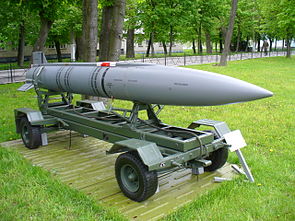Raduga Ch-15
| Raduga Ch-15 | |
|---|---|
| General Information | |
| Type | Air-to-surface missile |
| Local name | Ch-15, RKW-15 |
| NATO designation | AS-16 kickback |
| Country of origin |
|
| Manufacturer | Raduga design office |
| development | 1978 |
| Commissioning | 1988 |
| Working time | in service |
| Technical specifications | |
| length | 4.78 m |
| diameter | 455 mm |
| Combat weight | 1,200 kg |
| span | 920 mm |
| drive | Solid rocket engine |
| speed | Mach 5.0 (1,670 m / s) |
| Range | 200-280 km |
| Furnishing | |
| steering | Inertial navigation system |
| Warhead | Nuclear warhead 350 kt |
| Detonator | Programmed detonator |
| Weapon platforms | bomber |
| Lists on the subject | |
The Raduga Ch-15 ( Russian Х-15 , NATO code name AS-16 Kickback ) is a supersonic air-to-surface missile for combating strategic ground targets.
development
The Ch-15 was developed as a counterpart to the US AGM-69 SRAM . Development began in 1978 in the Raduga design office in Moscow . The system was introduced to the Soviet Air Force in 1988 . The Ch-15 was presented to the public for the first time in 1992. In the West, this system was nicknamed "SRAMski" because it is similar to its US counterpart.
variants
- Ch-15 (RKW-15)
- Standard version, controlled by an inertial navigation system , with a 350 kT nuclear warhead. Range 200–280 km.
- Ch-15P
- Version with improved precision and a range of 300–350 km. Development stopped in 1991.
- Ch-15E
- Anti-radar version with a passive radar seeker head and a 150 kg fragmentation warhead. Range 120–150 km. Development stopped.
- Ch-15S / A
- Version for anti-ship combat , presented in 1993. With a 150 kg penetration warhead and active radar search head in the K u band. Range 120–150 km. Development stopped.
- Ch-15SE
- Export version of the Ch-15A.
technology
The surface of the streamlined fuselage of the Ch-15 is made of a heat-resistant tungsten - molybdenum alloy. An additional thermal insulation layer is applied to the tip of the guided weapon . There are three aerodynamic control surfaces made from a titanium alloy on the rear of the missile . The Ch-15 is powered by a high-energy 9A2001 dual pulse solid rocket engine from OKB Soyuz . This works with two different thrust levels for take-off and cruise flight. The rocket drive can pause between the ignition of the start and march drive.
Before starting, the coordinates of the target must be entered in the missile's navigation system . This can be done on the ground or on board the carrier aircraft. The Ch-15 can be launched at an altitude of 300–22,000 m. After being dropped from the aircraft, there is initially a short period of non-propulsion. The rocket engine in the rear of the guided missile only ignites at a safe distance from the aircraft. Then the missile rises in an aeroballistic trajectory to an altitude of 40,000 m. The target approach takes place in a steep dive at a speed of Mach 5. To cover a flight distance of 200 km, the Ch-15 needs between 180 and 200 seconds. The minimum operating distance is 40 km. The thermonuclear warhead can be detonated with a proximity detonator in the air or triggered with the impact detonator on contact with the ground.
Targets for the Ch-15 are military airfields, radar stations, air defense positions and command posts.
Carrier aircraft
- Tupolev Tu-95 Bear with a maximum of 12 guided missiles
- Tupolev Tu-22M Backfire with a maximum of 6 guided missiles
- Tupolev Tu-160 Blackjack with a maximum of 24 guided missiles
literature
- Thomas Newdick: Postwar Air Weapons 1945 - Present . Amber, London 2011. ISBN 978-1-907446-59-7 .
Individual evidence
- ^ A b Jane’s Air-Launched Weapon Systems. Edition 2002, Ducan Lennox, Jane's Information Group 2002
- ↑ a b www.airwar.ru , accessed: January 23, 2014 (Russian)
- ↑ a b Thomas Newdick: Postwar Air Weapons 1945 - Present . 2011. p. 74.
- ↑ a b militaryrussia.ru , accessed: January 23, 2014 (Russian)
- ↑ a b rbase.new-factoria.ru , accessed: January 23, 2014 (Russian)
